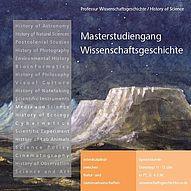Vita
2020 – 2023: Wissenschaftlicher Mitarbeiter am Lehrstuhl Wissenschaftsgeschichte TU Berlin
2020: Scholar in Residence am Deutschen Museum München
2019: Wissenschaftlicher Mitarbeiter in der MPG Nachwuchsgruppe "Historical Epistemology of the Final Theory Program" (MPIWG)
2017 - 2019: Post-Doc am Berliner Zentrum für Wissensgeschichte (MPIWG / TU Berlin)
2011 - 2016: Doktorand am Max Planck Institut für Wissenschaftsgeschichte Berlin
Publikationen
Monographien
2019
Practicing the Correspondence Principle in the Old Quantum Theory: A Transformation Through Implementation. Archimedes. Dordrecht: Springer.
Artikel
2023
“Real Virtuality and Actual Transitions: Historical Reflections on Virtual Entities before Quantum Field Theory” mit Alexander Blum, special issue in Perspectives on Science (in print)
“Quantum Mechanics, Radiation and the Equivalence Proof” mit Alexander Blum. Archives for the History of the Exact Sciences (in print)
2022
“The Birth of Quantum Mechanics from the Spirit of Radiation Theory” mit Alexander Blum. Studies in the History and Philosophy of Modern Physics 91: 125-147.
“The Early Interpretational Debate on Quantum Mechanics,” mit Christoph Lehner in: Olival Freire et.al. (eds.) Oxford Handbook of the History of Interpretation of Quantum Physics, Oxford: Oxford University Press, 135–173.
2017
“Translation as Heuristics: Heisenberg’s Turn to Matrix Mechanics,” mit Alexander Blum, Christoph Lehner und Jürgen Renn. Studies in the History and Philosophy of Modern Physics 60: 3–22.
2015
“Practising the Correspondence Principle in the Old Quantum Theory: James Franck, Friedrich Hund, and the Ramsauer Effect” in: Finn Aaserud und Helge Kragh (Hg.) One Hundred Years of the Bohr Atom: Proceedings from a Conference. (=Scientia Danica. Series M: Mathematica et physica, Bd. 1), Det Kongelige Danske Videnskabernes Selskab: Kopenhagen: 200–216.
2013
“The Correspondence Idea in the Early Bohr Atom 1913–1915” Annalen der Physik 525 (10–11): A155–A158.
Vorträge (Auswahl)
2022
Development in and out of Sensitometry: Development in and Out of Sensitometry. Photographic Science and Practice Circa 1890. Workshop After Exposure ETH Zürich.
2021
Substitute Radiators, Virtual Oscillators, and Actual Transitions: Radiation Processes in the Old Quantum Theory and Quantum Mechanics (1913–1927). Virtual entities in science: a virtual workshop. RWTH Aachen & TU Berlin
2020
Die Vermessung des Instabilen: Hermann Vogel und sein Photometer am Deutschen Museum. Arbeitskreis Forschung. Deutsches Museum München [pandemiebedingt abgesagt]
2019
Die Vermessung des Instabilen: Photometrische Wissenspraktiken und Technologien des Lichts (1830-1880). Masterseminar der Professur für Wissenschaftsgeschichte, Universität Regensburg
Der Leuchtturm als Camera Obscura: John F. Campbell und die Royal Commission on Lights, Buoys, and Beacons (1860)
Zwischen Meer und Fabrik. Photometrie der Leuchttürme ca. 1860. Forschungskolloquium zur Geschichte des Wissens. Humboldt-Universität zu Berlin
2018
Transformation Through Implementation: The Evolution of the Correspondence Principle (1918–1926). &HPS7 The Evolution of Knowledge. Hannover
2017
The Formation of a Paper Tool: Intensity Schemes in the Old Quantum Theory. Symposium Quantum Cultures / 25th International Congress for the History of Science and Technology. Science, Technology, and Medicine between Global and Local. Rio de Janeiro
2016
Between Problem Solving and Conceptual Development: The Correspondence Principle as a Research Tool (1918–1926). Transitions: The Eighth British-North American Joint Meeting of the BSHS, CSHPS, and HSS, Edmonton
2015
Revisiting Umdeutung: The Correspondence Principle and the Intensity Problem 1922–1925.
Fourth Conference on History of Quantum Physics Donostia/San Sebastian
2013
The Correspondence Principle in Practice: Its Use and Dispersion in the Old Quantum Theory. 100 Years of the Bohr Atom, Kopenhagen


